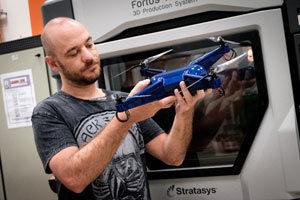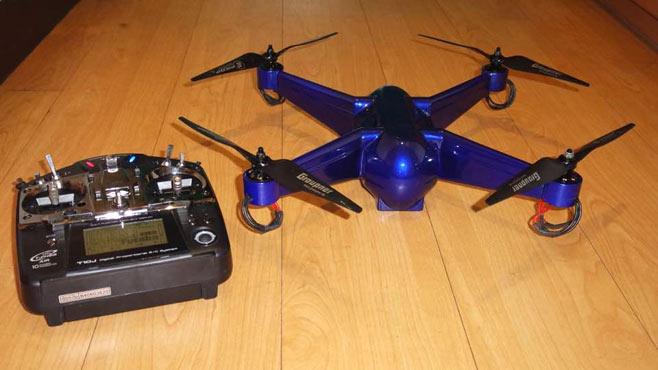We’ve talked about search and rescue drones, and even a drone that could help fight fires. But what about a drone that could, theoretically, fly into the extremely hot environment of a volcano? Stratasys Asia Pacific approached NTU (Nanyang Technological University) Singapore PhD student Phillip Keane to see if it were possible to embed off-the-shelf electronics, and combine with 3D printing in a high temperature environment, using an FAA-certified thermoplastic, in order to produce a super heat-resistant drone. As it turns out, it is possible!
Keane, who’s already successfully launched a CubeSat company, is currently researching the applications of ULTEM 9085, Stratasys’ aerospace-grade, high-strength FDM 3D printing material at NTU’s Singapore Centre for 3D Printing. He designed a sturdy quadcopter that can, in principle, survive in temperatures that exceed the limits of commercially available drones. Embedded electronics are certainly not unheard of in drones, but the incredibly high temperatures were: the ULTEM 9085 material requires a print chamber temperature with a minimum of 160°C, and an extruder temperature in the 300°C region.
 The real goal was to see if they could combine PCB installation and 3D printing in one stage, and, in theory, have the drone be flight-ready as soon as it was out of the printer. Keane outlined some of the project challenges while talking with Michael Swack. The first hurdle was designing the drone so it did not have any internal support material. This was accomplished by designing the interior of the drone with self-supporting 45° angles. To make the battery cavity, which would eventually house the embedded electronics, they 3D printed a flat plate separately, and installed it during the print process, so as to create the void without using any hard-to-remove supports. In order to keep a curved exterior, while still having an angular interior, Stratasys Insight software was used to fill surplus areas with a honeycomb-like structure.
The real goal was to see if they could combine PCB installation and 3D printing in one stage, and, in theory, have the drone be flight-ready as soon as it was out of the printer. Keane outlined some of the project challenges while talking with Michael Swack. The first hurdle was designing the drone so it did not have any internal support material. This was accomplished by designing the interior of the drone with self-supporting 45° angles. To make the battery cavity, which would eventually house the embedded electronics, they 3D printed a flat plate separately, and installed it during the print process, so as to create the void without using any hard-to-remove supports. In order to keep a curved exterior, while still having an angular interior, Stratasys Insight software was used to fill surplus areas with a honeycomb-like structure.
The drone was completed in less than 14 hours. It was 3D printed on the commercial grade Stratasys Fortus 450mc, and the print only had to be paused three times, for the electronics to be installed in the chassis. It was also printed upside down, to prevent the motor shaft colliding. But everything else, from the wiring harnesses to the flight controller, was fitted during the print, and sealed within the airframe by the printer. Since the ULTEM material is so strong, Keane was curious to see just how strong he could make the drone.
When speaking with Swack, Keane said, “I was interested to see how FEA simulations of the drone structure compared to real life tests. So I designed a test piece of one of the drone arms and 3D printed multiple copies with a variety of different air gap parameters (resulting in different weights and strengths). Upon testing, we showed a difference of around 15% between the simulations and the actual tests. In other words, each drone arm could carry 20kg before failing in simulation, compared to 17kg in real life. There are four drone arms, so the drone is capable of supporting a mass of around 68kg as a distributed load. Of course, as we are using small propellers and motors, the drone itself could never actually generate so much thrust as to lift that weight, but it’s still nice to know that our drone is rugged!”
 Speaking of rugged, Keane explained how long the drone could survive in high temperatures. The main structure, and the electronics, can survive in over 150°C for several hours. The motors use high-temperature rated neodymium magnets, which are good up to 180°C. But the drone is only as heatproof as its weakest link, which in this case is the battery. Their battery is good up to around 100°C for short amounts of time, so the overall operating temperature of the drone is about 100°C. They also had to remove some of the components from the PCBs and replace them with high temperature equivalents, so they would actually survive the 3D printing process.
Speaking of rugged, Keane explained how long the drone could survive in high temperatures. The main structure, and the electronics, can survive in over 150°C for several hours. The motors use high-temperature rated neodymium magnets, which are good up to 180°C. But the drone is only as heatproof as its weakest link, which in this case is the battery. Their battery is good up to around 100°C for short amounts of time, so the overall operating temperature of the drone is about 100°C. They also had to remove some of the components from the PCBs and replace them with high temperature equivalents, so they would actually survive the 3D printing process.
“Bear in mind,” Keane said, “this was just a prototype intended to demonstrate the process of installing the electronics mid-print. It wasn’t our goal to design a heat-resistant drone. It just happened as a result of the process. Future iterations can be improved now that we have a new goal to aim for. We have found some high-temperature batteries that will allow temperatures approaching 200°C.”
As mentioned earlier, this could potentially, in the future, help drones survive while completing projects like mapping the terrain around volcanoes.

The battery cavity which was embedded in the 3D printed quadcopter, produced on a Stratasys Fortus 450mc 3D Printer
Keane also thinks there is a lot of value in embedding the hardware right into plastic structures, by reducing the need for any additional hardware mounting fixtures. This helps when you’re trying to make the drone more lightweight. Additionally, since you are sealing the hardware inside the structure, it’s protected from the environment without using any excessive mechanical seals. For more information on the applications of this drone, and instructions for completing the project, read here.
So what’s next for Keane, once he finishes his research with NTU? He says he’d like to keep designing with the ULTEM 9085 material, and maybe even build an underwater drone. To see the drone in action, check out the video:
https://youtu.be/bEbK5p4Bx6o
Discuss in the 3D Printed Drone forum at 3DPB.com.
[Source/Images: Stratasys]
Subscribe to Our Email Newsletter
Stay up-to-date on all the latest news from the 3D printing industry and receive information and offers from third party vendors.
Print Services
Upload your 3D Models and get them printed quickly and efficiently.
You May Also Like
Reinventing Reindustrialization: Why NAVWAR Project Manager Spencer Koroly Invented a Made-in-America 3D Printer
It has become virtually impossible to regularly follow additive manufacturing (AM) industry news and not stumble across the term “defense industrial base” (DIB), a concept encompassing all the many diverse...
Inside The Barnes Global Advisors’ Vision for a Stronger AM Ecosystem
As additive manufacturing (AM) continues to revolutionize the industrial landscape, Pittsburgh-based consultancy The Barnes Global Advisors (TBGA) is helping shape what that future looks like. As the largest independent AM...
Ruggedized: How USMC Innovation Officer Matt Pine Navigates 3D Printing in the Military
Disclaimer: Matt Pine’s views are not the views of the Department of Defense nor the U.S. Marine Corps Throughout this decade thus far, the military’s adoption of additive manufacturing (AM)...
U.S. Congress Calls Out 3D Printing in Proposal for Commercial Reserve Manufacturing Network
Last week, the U.S. House of Representatives’ Appropriations Committee moved the FY 2026 defense bill forward to the House floor. Included in the legislation is a $131 million proposal for...



































